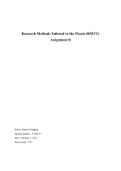Research Methods Tailored to the Thesis (RMTT)
Assignment B
Name: Jeanne Grupping
Student number: 11264217
Date: February 3, 2023
Word count: 1797
, 1. Participants
1.1. Sample
Prior to the analyses, all participants who did not approve consent or who were Florida
citizens, were removed from the sample. One participant indicated his/her exact age to be
‘240’, but also indicated to belong to the age category ‘18 - 30 years’, therefore the age was
manually adjusted to 24 and the participant remained included in the sample. This resulted in
a total of 729 participants who completed the survey. The researchers aimed to capture
sufficient variance in their sample, both in terms of composition (age, gender, education) and
political ideology. The participants (N = 729) were aged between 18 and 91 years old (M =
47.78, SD = 17.31), of which 49.4% was male (N = 360), 50.5% was female (N = 368) and
0.1% did not indicate their gender (N = 1). Regarding their education, 28.1% of all
participants did not possess a high school diploma or equivalent (N = 205), 43.5% did go to
college but did not obtain their final college degree (N = 317), and 28.4% graduated college
(N = 207). The researchers also managed to include an equal amount of opposed partisans in
their sample: 44.6% of the participants considered themselve a Democrat (N = 325), 44.3%
considered themselve a Republican (N = 323), and 11.1% considered themselve an
Independent voter (N = 81).
2. Measurements: Independent variables
2.1. Manipulation checks
To test whether the manipulation of the independent variable ‘corrective information’
(SecondText) worked as intended, an Independent Samples T-test was conducted in SPSS
with the independent variable and the manipulation check items (measured on a 7-point scale
ranging from 1 = Completely disagree, to 7 = Completely agree). Results confirmed that the
manipulation of corrective information was successful for all items (‘satirical’, ‘serious’,
‘earnest’), except one (‘funny’). Participants assigned to the fact-oriented condition (N = 248)
generally perceived the corrective information as more serious (M = 5.25, SD = 1.58) than
participants in the satirist condition (N = 238) did (M = 4.60, SD = 1.80), t(484) = 4.26, p <
.001, d = .39. Additionally, participants in the fact-oriented condition also rated the corrective
information as more earnest (M = 4.84, SD = 1.64), compared to participants in the satirist
condition (M = 4.30, SD = 1.77), t(484) = 3.49, p < .001, d = .32. On the other hand,
participants assigned to the satirist condition generally perceived the corrective information
as more satirical (M = 4.29, SD = 1.86), compared to participants in the fact-oriented
condition (M = 3.49, SD = 1.91), t(484) = -4.69, p < .001, d = -.43. Although participants in
1




